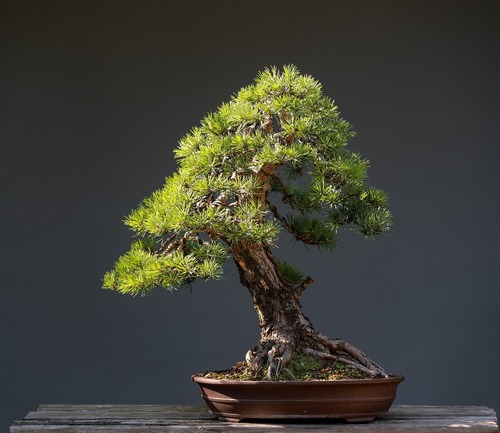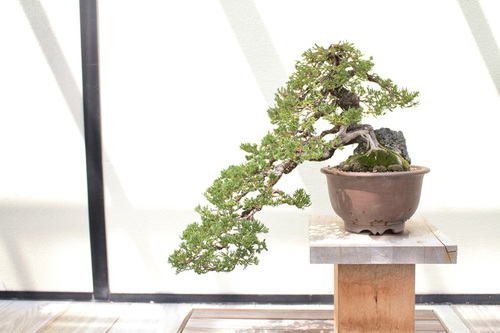A Beginner’s Guide to Bonsai Trees
Introduction
For those of you who love trees but simply don’t have the space for them in your yard , have you ever considered the captivating world of bonsai trees? Bonsai , a Japanese art form, involves cultivating and nurturing miniature trees that mimic the grandeur of their full-sized counterparts. This age-old tradition, spanning over a millennium, brings to life unique and visually stunning creations. Bonsai trees are not only aesthetically pleasing but are also relatively straightforward and easy to grow and maintain. If you’re keen to embark on a bonsai journey, you’ve come to the right place. In this in-depth guide, we’ll explore the art of growing, planting, nurturing, and acquiring bonsai trees.
Common Bonsai Tree Styles

A Rounded Bonsai Tree Surrounded with a Flowered Hedge
Before delving into the intricacies of bonsai cultivation, let’s take a closer look at some of the most common bonsai tree styles you might encounter.
Informal Upright Style (Moyogi)
The informal upright style, or Moyogi , is characterized by an upward-growing tree with gentle curves in its trunk. As the trunk emerges from the soil, it initially angles before winding back and forth several times on its way to the tree’s pinnacle. You have most likely seen this type of bonsai tree, as it is the most common variety. This style is an ideal choice for beginners and suits most tree species, particularly deciduous and flowering trees like elms, prunus, quinces, and maples.
Formal Upright Style (Chokkan)
In the formal upright style, the tree’s trunk grows completely straight and upright, exhibiting a visible taper, with the widest part of the trunk at the base. This growth is facilitated by a suitable radial nebari , or root structure. This style mirrors the natural growth pattern found in certain tree species, such as specific conifers, as well as trees growing in open areas without having to compete for sunlight. Formal upright bonsai trees exude an air of regality and timelessness, making them excellent additions to any setting.
Slanting Style (Shakan)
The slanting style bonsai tree features a trunk that grows at an angle from the surface on which it is cultivated. The result is a tree that appears to have been blown sideways by a powerful gust of wind. This unique and captivating style is an excellent conversation starter and adds an intriguing twist to your bonsai collection.
How to Get Started with Bonsai Trees

An Evergreen Bonsai Tree
Starting your journey with bonsai trees involves several essential steps :
Selecting the Right Tree Species
Choosing the appropriate tree species for your local climate is crucial. Bonsai trees can be crafted from almost any type of tree, including some tropical varieties that may not be suited for all types of weather. To make the best choice, determine your region’s hardiness zone and select trees that thrive in that climate. Seek guidance from experts at local plant nurseries and garden supply stores to make an informed selection.
One popular bonsai tree species is juniper, a hardy evergreen that can survive any northern climate and some warmer regions as well. Spruces, cedars, and pines are also extremely popular choices, and we love using trees like Japanese maples, elms, and oaks as well. As for tropical plants, jade and snow rose are great choices for indoor bonsai trees in temperate or cool climates.
Indoor or Outdoor Bonsai
Decide whether your bonsai tree will be indoor or outdoor. The choice significantly influences the tree’s care requirements . Indoor bonsai trees typically receive less light and require drier conditions, while outdoor bonsai trees benefit from natural sunlight and rainfall. Select tree species accordingly:
- Common outdoor choices: maple, birch, beech, ginkgo, elm, larch, juniper, and cypress trees.
- Common indoor choices: gardenia, Kingsville boxwood, ficus, serissa, and Hawaiian umbrella trees.
Consider Size
Bonsai trees come in a large variety of sizes; fully grown trees can be anywhere from as small as six inches to up to three feet tall, depending on the tree species. Assess the available space in your home or garden as well as the container’s size and sunlight accessibility. Ensure that the chosen bonsai tree’s size aligns with these factors.
Choosing a Healthy Plant
When selecting your bonsai tree, opt for a vibrant and healthy one with fresh, green leaves or needles. You can either choose to grow it from a seed, a cutting, or a preexisting plant.
- Seed: Growing from seed provides full control over the tree’s development but requires patience, as it can take up to five years to reach maturity. This is a great option if you want something to invest in over a few years and don’t mind not having the final product right away.
- Cutting: A cutting is simply a branch cut from a growing tree and transplanted to new soil to start a separate (but 100 percent genetically identical) plant. Propagating a bonsai tree from a cutting offers control without the extended wait associated with seeds.
Selecting the Right Pot
Bonsai trees are potted in containers that restrict their growth. Choose a pot large enough to accommodate sufficient soil for the tree’s roots. Adequate soil volume ensures the tree retains the moisture it needs. Additionally, make one or two drainage holes at the pot’s bottom to prevent root rot and maintain the tree’s health.
Many beginners start with practical containers and transition to more aesthetically pleasing ones once the trees are fully grown. This approach is wise, especially when working with delicate tree species, as it avoids investing in an expensive container prematurely.
How to Pot Your Bonsai Tree

A Bonsai Tree Cascading Down from its Planter
Potting your bonsai tree involves several crucial steps:
- Remove the Tree: Gently remove the tree from its original container, taking care not to damage or break the main stem. A potting shovel can assist in carefully prying the plant out without harm.
- Clean the Roots: Eliminate any dirt caked in or around the root system using tools like chopsticks, tweezers, or root rakes.
- Prune the Roots: Root pruning is essential to control excessive growth. If its growth is not controlled well, the bonsai tree may very well try to outgrow its container. Simply cut any large, thick roots, as well as any that face upwards off of the root system, leaving behind a network of slim roots near the soil’s surface. This promotes better water absorption, as water is primarily absorbed through the root tips.
- Prepare the New Pot: Ensure the new pot has a base of fresh soil that matches your desired tree height. Place a layer of coarse-grain soil at the pot’s base and add a looser, well-draining medium soil above it. Make sure the soil drains well to prevent overwatering. Leave some space at the top to enable you to cover the tree’s roots.
- Position the Tree: Place the tree in the pot as desired, ensuring it aligns with your aesthetic vision. Cover the roots with the remaining well-draining soil to secure the tree. Optionally, add a final layer of moss or rocks for added visual appeal.
- Stabilize the Tree: If your tree struggles to stand upright, insert a heavy gauge wire through the pot’s bottom drainage holes and secure it around the root system for stability.
- Prevent Soil Erosion: Install mesh screens over the pot’s drainage holes to prevent soil erosion caused by water runoff.
Pruning and Shaping Your Bonsai Tree

A Special Pink-Flowered (Sakura) Bonsai
Pruning plays a pivotal role in maintaining the health and aesthetics of your bonsai tree. There are different types of pruning to consider for your plant to look and feel good:
Pruning for Aesthetics
To preserve your tree’s health and growth, only perform aesthetic pruning during the dormant period, typically from November to February. Focus on the following:
- Remove Large Branches: Trim back large branches protruding from the tree as well as those with unnatural twists or unsightly appearances. Cut each branch above a node in a place that keeps the tree looking balanced.
- Trim Twigs and Branches: Trim twigs and branches on the tree’s canopy to enable light to filter through and reach the lower branches. This helps shape the canopy and maintain balance.
- Remove Suckers: Pluck off any small offshoots (suckers) growing on branches or at the trunk’s base to maintain a neat appearance.
Pruning for Maintenance
Regular maintenance pruning is essential for your bonsai tree’s health and appearance. You should use the best tools and wire for your bonsai . Follow these steps year-round, with an emphasis on spring and summer:
- Remove Dead Wood, Weeds, and Leaves: Clear the area around the bonsai pot and the tree itself of dead wood, weeds, and leaves. Take care not to damage the roots while removing weeds.
- Trim Broken or Crossed Branches: Remove crossed branches as they can create entry points for pests and diseases. Broken branches should also be removed to allow the tree to direct all its energy to new growth.
- Shorten Twigs: Trim twigs to have only 3-4 nodes (the joints from which leaves grow.) This ensures a well-balanced branch structure.
After pruning, apply wound paste to cover cuts, promoting healing and preventing excessive sap leakage. Water your bonsai tree immediately to encourage new growth, watering deeply to saturate the soil. Regular, light watering is recommended once a day, with deeper watering after pruning.
Additionally, apply a 7-7-7 fertilizer every two weeks during active growth. Use liquid fertilizer for smaller bonsai trees and granular fertilizer for larger ones. Dilute the fertilizer to half-strength or use half the recommended amount to avoid overfeeding.
Our Final Thoughts

A Spiraled Bonsai with Yellow Flowers
We trust that you’ve found our guide informative and inspiring for your bonsai tree endeavors. Bonsai trees offer a unique and captivating way to connect with nature, providing stunning, miniature works of art that can grace any environment. Whether you’re a seasoned bonsai enthusiast or a beginner, the world of bonsai trees welcomes you to explore its rich traditions and endless possibilities. Have you ever grown a bonsai tree before? If not, which tree species are you most excited to cultivate as your very own bonsai masterpiece? Share your thoughts and experiences as you embark on this fascinating journey into the world of miniature trees.
Originally posted on August 24, 2018
We may receive affiliate compensation for some of the links below at no cost to you if you decide to make a purchase.



